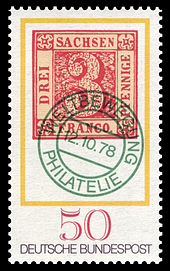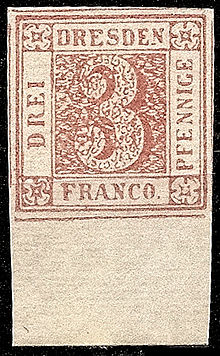Saxon threesome
| Saxon threesome | |
|---|---|

|
|
| output | |
| country | Kingdom of Saxony |
| Face value | 3 pfennigs |
| First day | June 29, 1850 (valid from July 1) |
| Date of Expiry | December 31, 1867 |
| layout | |
| Motif | Digit drawing |
| colour | red (tones) |
| draft | Scheele |
| Sting | |
| Print type | Letterpress |
| perforation | Cut |
| particularities | |
| Edition | |
| Edition | 500,000 (463,118 sold) |
The Sachsendreier is one of the most famous postage stamps in Germany . The correct name is Sachsen, Drei Pfennig red . It is the first postage stamp of the Kingdom of Saxony .
History and description
In order to be able to better organize the increasing volume of letters, the German-Austrian Post Association was founded, among other things . Because of this, Saxony introduced postage stamps. The role models were the experiences with postage stamps from postal areas that had already introduced postage stamps. After Bavaria , Saxony was the second German postal area to introduce postage stamps. The new stamp came out on June 29, 1850, but was only valid from July 1 of that year. This stamp was not yet intended for sending letters, but for franking printed matter, especially newspapers, in the wrapper. The mailers stuck half of the stamp on the wrapper and half on the printed matter, so that the newspapers could not slip out. When the wrapping paper that gave the address was severed, these stamps were mostly damaged, so that only a few copies of this stamp have survived undamaged.
The stamp owes its fame to many adventurous stories of discovery and there are many forgeries of it. The red color was slightly different depending on the edition, so there are several different color variants. In the current Michel catalog, individual stamps are valued at between 4,000 and 18,000 euros, depending on the shade .
The printing company JB Hirschfeld from Leipzig produced them using the letterpress process in a total print run of 500,000. This stock came out in eight editions on a total of 25,000 sheets of five by four stamps. Of these, the Post sold 463,118 units, the remainder was burned.
Today there are an estimated 3,000 to 4,000 pieces worldwide, most of which have been canceled or stamped by a pen; only about ten percent of the Saxon triplets that have been preserved are unused. Nevertheless, the market price for unused and used brands of Saxony No. 1 is about the same. In 2008 it was around 3,500 euros for flawless pieces, damaged and repaired copies are significantly cheaper.
Because of its popularity, the Saxon three served as a motif for several special postage stamp issues. At the end of the 19th century, the Dresden Transport Agency Hansa also issued private postage stamps, the design of which was heavily based on the first Saxon postage stamp.
Rare collectibles
There is a sheet with 20 of these stamps, it reached a price of 620,000 DM in 1966 . There are several different versions where exactly this bow was originally supposed to have been glued. It was definitely stuck to a wall. This arch was badly damaged after being removed from the wall and has been repeatedly restored. The sheet initially went to the Viennese dealer Sigmund Friedl for 400 gold marks. As early as 1875, Philipp von Ferrary acquired the bow for 2000 gold marks and in 1922 it went to the collector Burrus for 55,000 gold francs . In 1959, Walter Kruschel bought it when the Burrus collection was dissolved. In 1964 E. Anderegg bought it for DM 215,000. Most recently, a Wiesbaden stamp auction house auctioned this unused sheet for DM 920,000 at the beginning of 1999; the previous owner was Ulrich D. Schulze, who inherited it from his father.
Another arch was cut in the 1890s. A block of 6 is owned by the Museum für Kommunikation in Berlin and a further block of 4 from the lower right corner of this arch was in the collection of John R. Boker Junior .
A compilation of more than 90 known connected units of the brand, i.e. blocks and stripes, is in the Rauhut & Kruschel auction catalog, the auction on August 29th and 30th, 2014.
literature
- The Saxons 3 Pfenning. In: Julius Kaufmann: Twelve famous postage stamps. Self-published, Tel Aviv 1960, pp. 93–99
- C. Bohnert: The red Saxon triple stamp. (Continuation article ) In: Illustrierter Briefmarken-Journal , from No. 2/1910, pp. 29–32
- Georg Bühler: Saxony 3 Pfennig red , self-published 1978
- Friedrich W. Dieck: Handbook of Postage Stamps of the Kingdom of Saxony , Leipzig 1921 ( online )
- Arnim Knapp: The "Saxon Dreier" of the royal Saxon postal administration , Heinrich Köhler GmbH & Co. KG, Wiesbaden 2010, 190 pp.
- Jürgen Kraft: Ratgeber Sachsen In: stampsX-Projekt Link: Ratgeber ( online )
- Wolfgang Maassen: Legends of Philately: The "Saxony-Dreier-Bogen". In: Phila Historica issue No. 1/2013, pp. 63–71
- Ewald Müller-Mark: Old Germany under the magnifying glass , Volume II, 7th edition, Verlag M. Zieme, Oberursel
- Walter Opitz: The Red Three is 100 years old. In: Collector Express from January 1, 1950
- LN Williams: Encyclopaedia of Rare and Famous Stamps. Volume 1 (The Stories), Feldman, Geneva 1993, ISBN 0-89192-435-3 , pp. 84 f
Individual evidence
- ↑ a b c L. N. and M. Williams: Rare postage stamps. Parkland Verlag Stuttgart, p. 68 f
- ↑ Twenty Saxon threes on the wall. In: Wolfgang Jakubek: Knaur's stamp book. The whole world of philately. Publisher: Droemer Knaur, Munich / Zurich 1976, ISBN 3-426-02244-3 , p. 213 ff
- ↑ a b c d e Jan Billion. In: Deutsche Briefmarken-Revue No. 1/1999, pp. 16-17 (title topic)
- ↑ Jan Billion: Saxony Dreier. A minimum of DM 10,000 is due for perfect preservation. In: Deutsche Briefmarken-Revue (DBR) No. 7/2000, p. 43 f; see also DBR 1/1999 (cover story) and DBR 3/1999, p. 10
- ↑ Biographies of the Preziosen. Sachsen-Dreier-Kartei in the Rauhut catalog. In: Deutsche Briefmarken-Zeitung issue No. 16/2014 of July 25, 2014, p. 44

